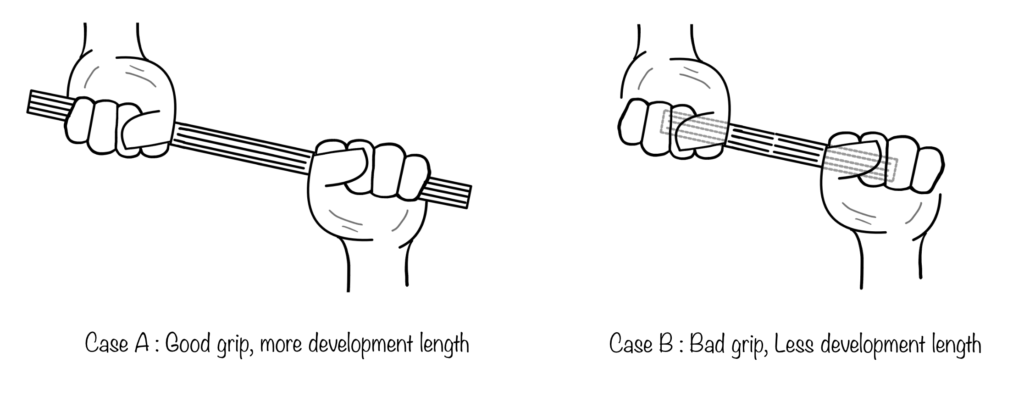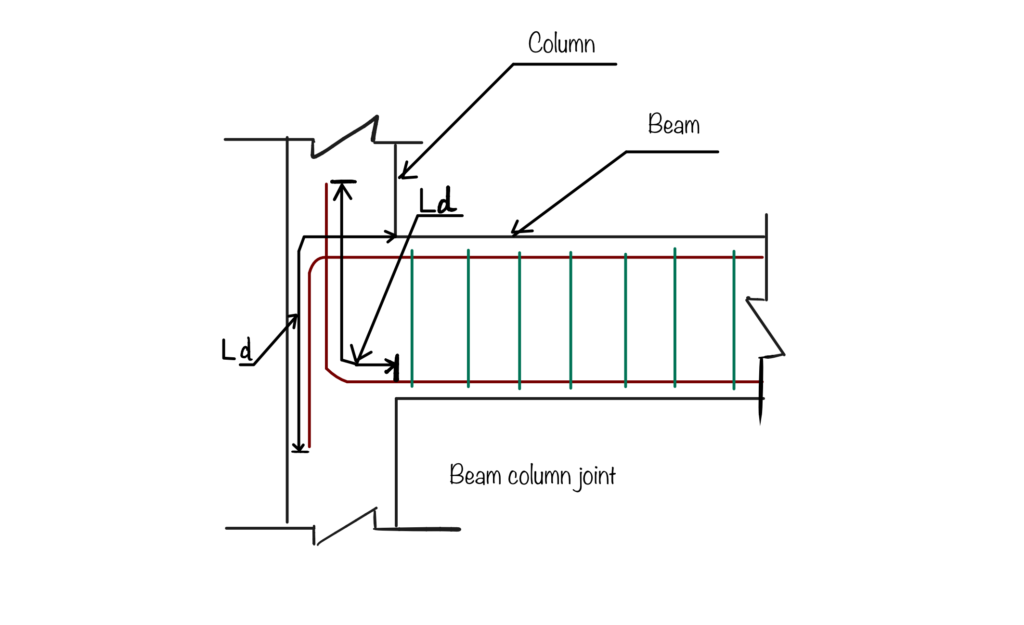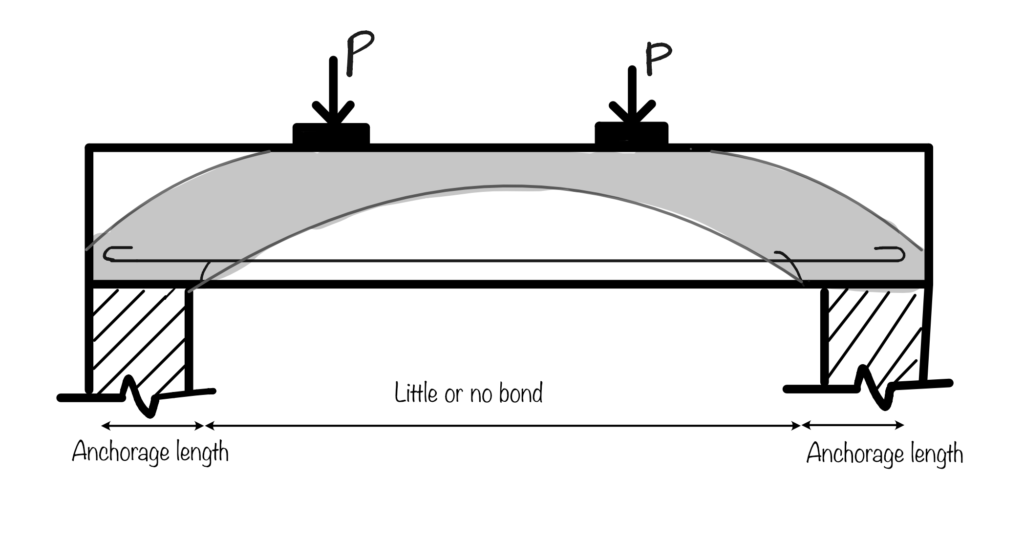To give you an idea of the significance of development length we will do a simple demonstration. Ask your friend to hold a pen or pencil in closed fist and you try to pull that out.You will feel the more length of the pen that is inside in his/her fist, the more you need to apply effort to get that out. This is what the concept of development length.

Thus, the development length may be defined as the length of embedment necessary to develop the full tensile strength of the reinforcement, controlled by either pull-out or splitting. In other words, a certain minimum length of the bar, called the development length, has to be provided on either side of a point of maximum steel stress to prevent the bar from pulling out under tension.

Now, let’s have an idea about the anchorage. In the case of plain bars, the bond is due to the chemical adhesion and mechanical friction between steel and concrete, but it is easily broken when a large load is applied. End anchorage is provided to prevent this. Such a beam will not collapse even if the bond is destroyed over the entire length, provided the anchorage is sufficient.

Why to provide development length ?
The stress at the end of a bar is zero; it builds up gradually along its length through bond with the surrounding concrete. To ensure this development length is required. The extra reinforcement length will help transfer the stresses developed in the junction, for example, in the beam-column joints.
Importance of Ld are as follows:
- To prevent premature bond failure: No premature bond failure will occur if the actual length L is equal to or greater than Ld.
- To promote bending failure: The beam is supposed to fail in bending or shear failure rather than bond failure. We promote bending failure in beams because it is a more predictable and controllable failure mode compared to other types of failure.
- To control the failure mechanism: In the case of the bond, we are considering the overall mechanism of failure rather than the limiting stresses to govern the design.
How to calculate development length as per IS :456 ?
According to Clause 26.2.1 of the Indian code, the calculated tension or compression in any bar at any section shall be developed at each side of the section by an appropriate development length, given by :
$$
L_{\mathrm{d}}=\frac{d_b f_{\mathrm{s}}}{4 \tau_{\mathrm{bd}}}
$$
where,
- db is the nominal diameter of the bar,
- fs is the stress in the bar at the section considered at design load (for fully stressed bar, fs = 0.87 fy)
- τbd is the design bond stress as per Table below.
| Grade of concrete | M20 | M25 | M30 | M35 | M40 and above |
|---|---|---|---|---|---|
| Design bond stress , MPa | 1.2 | 1.4 | 1.5 | 1.6 | 1.9 |
| For fully deformed bars | 1.18 | 1.37 | 1.54 | 1.71 | 1.87 |
Note : As per IS :456, one has to make the following changes in design bond stress value
- For deformed bar in tension: τbd values can be increased by 60 %
- For bars in compression: τbd values can be increased by 25 %
- For nominal reinforcement: τbd is taken as 1.0 MPa
$$
L_{\mathrm{d}}=\frac{0.136 d_b f_{\mathrm{y}}}{\tau_{\mathrm{bd}}}
$$
What is the reduction in development length due to excess reinforcement ?
The Indian and US codes follow for the reduction in development length by the ratio (Ast required )/ (Ast provided) when excess reinforcement is provided to resist the applied moment in a flexural member (SP: 24: 1983).
$$
{L’_{\mathrm{d}}}=L_{\mathrm{d}} \frac{A_{st-required}}{A_{st-provided}}
$$
where L’d is the actual development length and Ld is the development length of the fully stressed bars.
Note: We should not allow a reduction for tensile lap splices, development of positive moment at supports and development of shrinkage and temperature reinforcements. This is also not possible for reinforcement in structures located in regions with high seismic risk.
What is the development length of bars in compression ?
The real performance of bond in compression is a thing which requires research. The development length required is shorter for bars in compression than in tension because of the absence of tension cracking and it improves the effect of the end bearing of the bars in compression. Increase the value of bond stress in tension by 25 % – as per IS code.
What is the development Length of Bundled bars ?
For situations where heavy concentration of reinforcement is present, bundles of bars can save space and reduce congestion for placement and consolidation of concrete. Bundling of bars in column will result in better locating and orienting of the reinforcement for increased column capacity, also fewer ties are required if column bars are bundled. Equivalent diameters of bundled bars are given in table below :
| Bar diameter | Equivalent diameter, mm $$d_{eq} = d_{b} \sqrt{n_b}$$ | ||
|---|---|---|---|
| Two bar bundle | Three bar bundle | Four bar bundle | |
| 12 | 16.97 | 20.78 | 24 |
| 16 | 22.63 | 27.71 | 32 |
| 20 | 28.28 | 34.64 | 40 |
| 22 | 31.11 | 38.11 | 44 |
| 25 | 35.36 | 43.30 | 50 |
| 28 | 39.60 | 48.50 | 56 |
| 32 | 45.25 | 55.43 | 64 |
Increased development length for individual bars within a bundle, whether in tension or compression, is required when bars are bundled together. The additional length is required because there is no core of concrete between the bars to provide resistance to slipping.
What are the factors affecting development length ?
The factors which affect the development length are as follows:
- Compressive strength of concrete: The strength of the concrete can affect the development length, as stronger concrete can withstand greater loads and stresses.
- Reinforcement type: The type of bars used in the concrete can affect the development length. For example, deformed bars have a greater bond with the concrete than smooth bars, which can affect the development length.
- Rebar clear cover: The thickness of the concrete cover over the reinforcement can also affect the development length. Greater cover thickness can provide greater protection for the reinforcement.
- Rebar centre to centre spacing: The spacing of the bar can affect the development length. Closer spacing can provide greater support and stability.
- Environmental conditions: Exposure to environmental factors such as temperature, humidity, and exposure to chemicals can affect the development length.
- Rebar diameter: The size of the bar can also affect the development length. The large bars can withstand greater loads and stresses.
- Anchorages type: Different types of anchorages can affect the development length, for example, using hooks, hoops or bent bars can change the value of Ld.
- Shape of the member: The shape of the member and its size can also affect the development length.
Conclusions:
In conclusion, development length is an important aspect of steel design in construction. The Indian Standards (IS) codes provide guidelines for determining the required development length for different types of bars and different types of concrete. Adhering to the guidelines in the IS codes is crucial in ensuring the safety and integrity of the structure.
In this post, you learned the following key points:
- Bar strength: IS 456 suggests that the full capacity of bars should be used to calculate the required development length.
- Bars in compression: The development length required is shorter for bars in compression than in tension.
- Bundled bars: To calculate the development length for bundled bars, we need to calculate the equivalent diameter.
- Bond stress: You must increase the bond stress by 60%for deformed bars and 25% for bars in compression.
- Tensile lap splices: You should not allow any reduction for tensile lap splices, development of positive moment at supports and development of shrinkage and temperature reinforcements.
Check this post to read a brief about what is a slenderness ratio and why is it important in design.

Android Apps
⭐️ ⭐️ ⭐️ ⭐️ ⭐️ 1000+ | 400,000 + Downloads (Cumulative)
At eigenplus, our goal is to teach civil engineering students about structural analysis and design starting from the fundamental principles. We do this with the help of interactive android applications and accompanying web articles and videos.
Our apps have helped more than 400 thousand students across the world to understand and learn the concepts of structural engineering. Check out our apps on the google play store.
This article was crafted by a group of experts at eigenplus to ensure it adheres to our strict quality standards. The individuals who contributed to this article are:
Author


